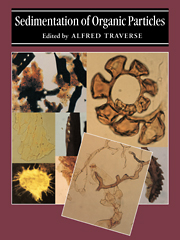Book contents
- Frontmatter
- Contents
- Editor's preface
- List of contributors
- I Introduction
- II Studies of palynosedimentation in modern environments
- III Reconstruction of late Cenozoic vegetation and sedimentary environments from palynological data
- IV Application of data on palynosedimentation to solution of geological problems
- 16 Palynology of sedimentary cycles
- 17 Particulate organic matter, maceral facies models, and applications to sequence stratigraphy
- 18 Association of palynomorphs and palynodebris with depositional environments: quantitative approaches
- 19 A quantitative approach to Triassic palynology: the Lettenkeuper of the Germanic Basin as an example
- 20 Palynomorph concentration in studies of Paleogene nonmarine depositional environments of Wyoming
- 21 Multivariate analyses of palynomorph data as a key to depositional environments of Upper Cretaceous and Paleogene coal-bearing rocks of the western United States
- 22 Relationships between depositional environments and changes in palynofloras across the K/T boundary interval
- 23 Sedimentation of palynomorphs in rocks of pre-Devonian age
- V Appendix
- Index
16 - Palynology of sedimentary cycles
Published online by Cambridge University Press: 06 January 2010
- Frontmatter
- Contents
- Editor's preface
- List of contributors
- I Introduction
- II Studies of palynosedimentation in modern environments
- III Reconstruction of late Cenozoic vegetation and sedimentary environments from palynological data
- IV Application of data on palynosedimentation to solution of geological problems
- 16 Palynology of sedimentary cycles
- 17 Particulate organic matter, maceral facies models, and applications to sequence stratigraphy
- 18 Association of palynomorphs and palynodebris with depositional environments: quantitative approaches
- 19 A quantitative approach to Triassic palynology: the Lettenkeuper of the Germanic Basin as an example
- 20 Palynomorph concentration in studies of Paleogene nonmarine depositional environments of Wyoming
- 21 Multivariate analyses of palynomorph data as a key to depositional environments of Upper Cretaceous and Paleogene coal-bearing rocks of the western United States
- 22 Relationships between depositional environments and changes in palynofloras across the K/T boundary interval
- 23 Sedimentation of palynomorphs in rocks of pre-Devonian age
- V Appendix
- Index
Summary
Introduction
The palynology of sedimentary cycles is based on the study of dispersed organic matter in rocks of various depositional lithofacies. This chapter describes how different kinds of organic particles can be used to detect depositional environments and their migration in response to change in sea level relative to the land surface. Episodes of marine transgression and regression affect the distribution and concentration of organic particles such as pollen grains and spores, algal fossils, the conductive tissue and cuticle of land plants, recycled palynomorphs and inertinite, and fecal amorphous debris. Several examples illustrate the evidence that palynology provides for cycles of transgression and regression. These were selected from contrasting lithological types, for example, siliciclastic sand to lime mud; different depositional environments, for example, shallow shelf versus carbonate platform; and different geologic ages, for example, Middle Jurassic, Late Cretaceous-Danian. An example of Permian-Triassic age illustrates how reworked palynomorphs can be used to detect cyclicity in the sedimentary record.
Organic particle sedimentology
The vast majority of particulate organic matter deposited in marine sediments consists of admixtures of material of both terrestrial and marine origin. The mixing of material from both sources occurs on the deep sea floor as well as on the shallow shelf. Commonly, one or two components predominate over others, and these can be used to trace the principal origin of the organic matter. Other parameters, such as the diversity and morphological sorting of organic particles, can be used to interpret hydrodynamic and ecological processes operating in the area of deposition.
- Type
- Chapter
- Information
- Sedimentation of Organic Particles , pp. 311 - 336Publisher: Cambridge University PressPrint publication year: 1994
- 7
- Cited by



